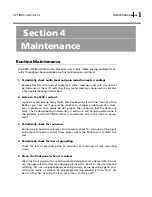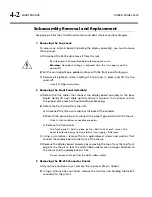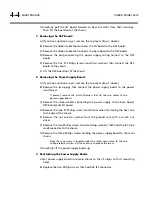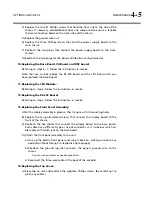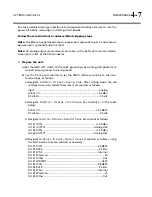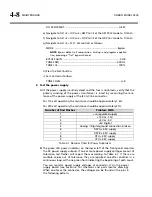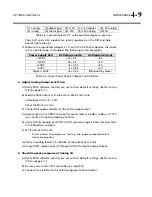
5-2
TROUBLESHOOTING ORBAN
MODEL
9400
Be sure that the polarity of the 9400’s output correctly matches the transmitter so
that adjusting the 9400’s
P
OS
P
EAK
T
HRESH
control (in the active Transmission Preset)
causes the AM positive peak modulation to change. If it causes the negative peak
modulation to change, reverse the polarity of the 9400 output driving the analog
AM channel of the transmitter. Each 9400 output has a
P
OLARITY
control to make this
easy.
The output of the 9400’s digital radio-processing path is accurately peak-controlled.
However, the HDC codec (used in the HD AM system) and the aacPlus codec (used in
the DRM system), like all low bitrate lossy codecs, introduce considerable overshoots
as a side effect of throwing away data. When you adjust the drive level into the co-
dec, it is wise to monitor the output of a radio or modulation monitor. If you see
clipping, reduce the drive level to the codec as necessary.
Excessively Low Positive Peak Modulation
The polarity of the 9400’s active output might be reversed. You can test this by edit-
ing the Polarity field in the active System Preset.
You may have not allowed enough peak headroom in the 9400’s output level set-
ting. Achieving 125% modulation requires 2 dB of headroom. To achieve 125% posi-
tive modulation, you must therefore set the AOx Out control to +18 dBu or lower, or
the DOx Out control to –2.0 dBfs or lower.
If you have a tube-type transmitter with high-level plate modulation, the modulator
tubes may be flat.
Audible Distortion On-Air
Make sure that the problem can be observed on more than one receiver and at sev-
eral locations. Multipath distortion at the monitoring site can be mistaken for real
distortion (and will also cause falsely high modulation readings).
Verify that the source material at the 9400's audio inputs is clean. Heavy processing
can exaggerate even slightly distorted material, pushing it over the edge into unac-
ceptability.
The subjective adjustments available to the user have enough range to cause audi-
ble distortion at their extreme settings. Many controls can cause distortion, includ-
ing
M
ULTIBAND
C
LIPPING
and
F
INAL
C
LIP
D
RIVE
. Setting the
L
ESS
-M
ORE
control beyond
“9” will cause audible distortion of some program material with all but the FINE
ARTS presets. Other presets can sometimes cause audible distortion with certain
program material; this is the price to be paid for maximizing coverage in AM broad-
cast.
If you are using analog inputs, the peak input level must not 27 dBu or the
9400's A/D converter will clip and distort.
Unlike earlier digital Optimods, there is no input peak level adjustment
for the A/D converter. Instead, we have provided adequate headroom for
virtually any facility. This is possible because the A/D converter in the
9400 has higher dynamic range than older designs. Therefore, without
Summary of Contents for Optimod-AM 9400
Page 1: ...Operating Manual OPTIMOD AM 9400 Digital Audio Processor Version 1 2 Software...
Page 7: ...Operating Manual OPTIMOD AM 9400 Digital Audio Processor Version 1 2 Software...
Page 52: ......
Page 204: ......
Page 232: ......
Page 260: ......
Page 261: ...OPTIMOD AM DIGITAL TECHNICAL DATA 6 29...
Page 267: ...OPTIMOD AM DIGITAL TECHNICAL DATA 6 35 CPU Module...
Page 273: ...OPTIMOD AM DIGITAL TECHNICAL DATA 6 41 RS232 BOARD PARTS LOCATOR...
Page 275: ...OPTIMOD AM DIGITAL TECHNICAL DATA 6 43 8300 POWER SUPPLY PARTS LOCATOR...
Page 284: ...6 52 TECHNICAL DATA ORBAN MODEL 9400 DSP BOARD PARTS LOCATOR DRAWING 32170 000 14...
Page 292: ...6 60 TECHNICAL DATA ORBAN MODEL 9400 DISPLAY BOARD PARTS LOCATOR...
Page 293: ...OPTIMOD AM DIGITAL TECHNICAL DATA 6 61 DISPLAY BOARD...


